|
FAQs about Oculinid/Galaxy Corals
1
Related Articles: Oculinids, Galaxy Corals,
Related FAQs: Oculinids 2, & FAQs on: Oculinid Identification, Oculinid Behavior, Oculinid Compatibility, Oculinid Selection, Oculinid Systems, Oculinid Feeding, Oculinid Health, Oculinid Reproduction/Propagation,
& Stony/True Coral,
Coral System Set-Up, Coral System Lighting, Stony Coral Identification, Stony Coral Selection, Coral Placement, Foods/Feeding/Nutrition, Disease/Health, Propagation, Growing Reef Corals, Stony Coral Behavior,
|
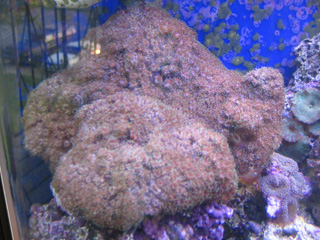
|
|
Creature ID/FAQ Direction... Oculinid
Resurrection! -11/25/07 Top of the morning WWM Crew, I have
browsed the site looking for some assistance with an ID. I
originally purchased 2 pieces of Live Rock that were barren at
the time, and since they have literally sprouted with some
interesting anemone looking creatures. The first two attached are
of the darker rock, upon which 15-20 tiny purple based with
greenish tip organisms have appeared. They do not appear to have
mouths like an anemone would, but they seem to be of the same
consistency based on how they move with the water flow in the
tank. The second set of pictures of are the lighter rock. I was
unable to snap a picture of the backside of this rock, but many
completely clear more pointed organisms are starting to emerge
out of these 'chambers'. Any assistance would be
appreciated, I would like to read more about these organisms, get
up to speed on whats in the tank! <Haha, that's not just
live rock my friend, that's coral! Apparently, whoever sold
it to you thought the coral was dead and so sold it to you as
"rock." But the coral (a Galaxea sp. from the looks of
it) is now coming back (and spectacularly so). Congratulations!
:)> Happy Holidays, -j <Gracias, y tu tambien, Sara
M.>
Re: Creature ID/FAQ Direction -11/25/07 Ahhh
Excellent! Thanks so much for your assistance I will read up
ASAP. I did not think my 2-t8 32 watt bulbs would be sufficient
to foster coral growth (55 gal tank) <Well, actually, Galaxea
sp. don't need much light.> But they seem to be
multiplying rapidly! <It's pleasantly surprising to me
too. Especially since, if it was sold as live rock, there must
not have been much more than a few bits of live tissue left. We
know that, theoretically, corals can come back from even just a
tiny "drop" of live tissue. But it's exciting to
see it actually happen (especially when you're not even
trying or don't even know it's there! lol). May I ask,
what do you feed the tank? It might be helpful for people
attempting to revive such dying corals to know more about your
system. And please don't be shy... if your nitrates are
through the roof or something, please share anyway. It's
always interesting, when someone has this kind of great,
unexpected success, to know all about the conditions under which
it happened. :)> Diligent research incoming, thanks again! -j
<Very good, but before you think about changing anything,
please keep in mind that whatever you've been doing, it's
been working for this coral. Best, Sara M.>
Re: Creature ID/FAQ Direction 11/26/07
Haha! Yes, I found both pieces in a live rock bin at a LFS,
walked out with both for under $20. The darker rock has
propagated quite a bit in the short amount of time it has been in
the tank (1 week). The lighter rock is beginning to sprout the
clear organisms I spoke about. Is the lighter rock a Galaxea
Coral as well? <Well, it was at one time. It's hard to say
if there's anything living left on it. I'm sorry I was
unable to see the "clear organisms" you were referring
too. It *could* be bleached out coral tissue. But I honestly
don't know without a better picture (and preferably with the
unknown thing circled).> Nothing to be ashamed about, I'll
post the stats. I also attached a picture of the tank. I
don't see anything out of the ordinary with my setup, is it
normally difficult to "revive" these type of corals?
<In my experience, it can be a difficult thing to do when
you're deliberately trying to do it. But, as you can see (and
as has happened to me too), sometimes they just come back without
much aquarist effort at all. Corals are just weird that way
sometimes (or they seem so because of how little we really
understand about them).> 55 gal 2 t8 32 watt bulbs (actinic
and full spectrum) Fluval canister filter with activated carbon.
3 Maxi-Jet 1200 Powerheads Inhabitants - O. Niger Trigger, Maroon
Clown, Longnose Butterfly. Assorted Hermits and Snails. Cleaner
Shrimp. Tank parameters Gravity - 1.023 PH - 8.3 Ammonia - 0
Nitrite - 0 Nitrate - 0 Temp - 78 <Your salinity and temp are
a little low (1.025 and 80-82F would be better). But like I said,
whatever you're doing is working so I wouldn't change
anything too quickly.> I feed defrosted Mysis shrimp once
daily soaked in Selcon. <Hmmm... maybe the Selcon is helping?
The strong water flow certainly doesn't hurt.> I was not
planning on changing anything (if its not broke....) but I was
curious if I needed to supplement feedings/care requirements of
the coral. Will research the FAQs. -j <Here are some links to
help you out: http://www.wetwebmedia.com/oculinidae.htm
http://www.wetwebmedia.com/galaxycfaqs.htm
http://wetwebfotos.com/Home?actionRequest=articleView&articleID=299
http://www.asira.org/galaxea They're actually not considered
"easy" corals to keep. They feed on small particle food
and, when healthy, can be extremely aggressive. If/as this coral
continues to grow/thrive, it will probably need to be feed more
and maybe given some space. But as they say in AA... best to take
it "one day at a time." :-) Good luck and thank you for
sharing about your coral/system, Sara M.>
|
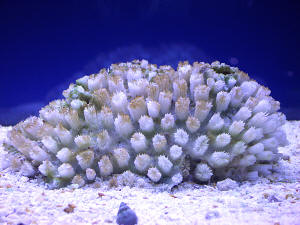 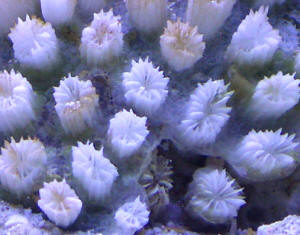 |
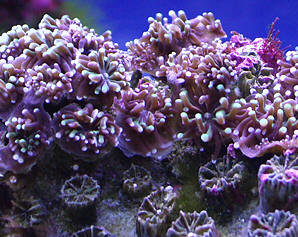 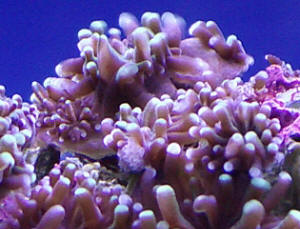 |
Copper treatment and Ammonia dilution; Galaxea problem
- 07/16/07 Hi Crew, <Hi.> I am treating my fish for ick with
a product called CopperSafe <good>. My clown goby that looked
real bad has cleared up and is eating, my spotted cardinal did not seem
to have it, but he stopped eating, but now is eating and my royal
Gramma had it, but did not seem too bad, but he died. I tested the
water for ammonia and it is at least 1. <Yikes, I hope you are
treating your fish in a tank without live rock/sand and invertebrates.
CopperSafe is a chelated copper product. While easier to handle than
ionic copper, it is still best to monitor the chelated copper level
with an adequate test kit.> I am using a product called AmmoLock for
ammonia and the fish seem ok. I am also making a 30% water change.
Should I make more drastic water changes? <Not a fan of this and
similar products in that case. While it may not hurt, I'd rather
rely on large water changes to keep the ammonia down and additionally
remove free stages of the parasites. Be sure to measure ammonia at
least daily and act accordingly.> I got a Galaxea, see pictures (550
is current and 531 is as it was 2 weeks ago) and it is not doing well.
It is in a 10 gallon with 65w pc. Does it need special feeding or more
light? <<RMF lost pix...>> <Ensure the water quality is
good at any time. Nitrates can be around 5, but temperature, salinity
and pH should not change too much. Your lighting should be sufficient,
but the small water volume might go through severe daily changes. Check
that. Try feeding it just like other LPS corals. Give it some time. If
its condition does not improve, it might do better in another tank.
Beware this coral is quite aggressive and can sting animals almost one
foot away. See http://www.wetwebmedia.com/oculinidae.htm and the linked
FAQs.> I cannot find much info about it. I got it as a package deal
and had no choice. I also got a very large Fungia but gave it away.
Should I do the same for the Galaxea? Thanks. <Welcome and good luck
with your treatment. Marco.>
Galaxea VS. Tridacnid 1/8/06 Hey! <…is for
horses. Just kidding, couldn't resist. Hello.> I recently
received a Galaxea (Oculinid) as a package deal on a piece of live rock
with a clam (T. Maxima, gorgeous). <Oh yes.> They are both
attached to the same large piece of rock. They are both currently doing
fine. But, I was surprised the first time the Galaxea busted out with
its sweepers. Those are long sweeps! <Oh yeah, have seen them
personally at 10 to 12 inches. And very potent I might add.> Anyway,
they are not touching the clam at this point, but if the coral
continues to do well I am concerned that it might touch the clam in the
future. Will the clam be affected? <Generally the sweepers are
extended at night when the clam is closed so it should not be too much
of a problem. However yes if the sweepers do come in contact with the
clam (the mantle most likely) this could cause some mantle recession,
which yes is very bad for a clam which needs the mantle for
photosynthesis. Keep an eye out.> Do these kids need to be sent to
different areas of the classroom? <Maybe, just keep a close watch as
I mentioned.> Thanks for your help and for fighting the good fight!
<Thank you for the encouragement.> Andy <Adam J.>
Coral Aggression: Galaxea 1/7/04 Brant here again,
<cheers> I really appreciate having such an informative
site. I wanted to mention in reference to my last
e-mail about white band that I also got a Galaxea at the
same time. I placed it on the top of a rock in
the center of the aquarium with some distance between
corals. <grumble, grumble... would rather have heard it
was placed properly in a QT tank first for 4+ weeks. We might not be
having this exchange if so <G>> The Stylophora is
only 3-4 inches away and is somewhat 'downstream' from the
Galaxea. <Yikes! The Stylo is soon to be Galaxy
coral food> I've read a lot about sweeper tentacles
<eventually 10" long from Galaxea... they are one of the
worst> and was wondering if this had anything to do with
my Stylophora problem. <very easily so> My salt level
is low also, at about 1.019. <do get this up to
1.023-1.025 for corals> Besides the Stylophora problem, I was
wondering if I could/should place my Galaxea directly on the
floor of the tank at the farthest distance from everything
else? <perhaps... they are one of the most aggressive
corals in the trade> Your help is greatly appreciated. Sincerely,
Chris Brant <best of luck, Anthony>
| Galaxea Coral Hi <Hi Gaurav> I have a question
regarding a tooth coral, Galaxea coral. I have one that is more
than 12 inches in diameter. it is getting too big for my aquarium
so I am thinking about fragging it. but I have never fragged a LPS
hard coral before so I need some suggestions on how to do it. <I
think fragging your coral is a wonderful idea. I'd like to
suggest you use Anthony Calfo's "Book of Coral
Propagation" as a reference and there are some wonderful
websites that deal specifically with coral
fragmentation. WWW.fragexchange.com is one that
immediately comes to mind> or do you have any better idea of
what I should do about it. I have included a few pictures of it for
reference. thanks for any suggestions you can give me. <If I may
quote Anthony, "Galaxeas are fused colonies of individual,
tubular corallites. Each cylinder crowned with a polyp can
theoretically live on its own when separated. Coral farmers take
colonies of Galaxea and rip paths between the corallites with an
electric saw. Wire saw blades work well for this approach.. . .
Propagated divisions laid on their side or against hard surfaces
will quickly encrust and continue to grow.> <I
also know people who use a Dremel and do it on a lesser level. Good
luck, Gaurav, I do encourage you to document what you do and post
it on one of the websites. MacL> Gaurav |
|

|
Galaxea Coral Question Mr. Fenner, Hopefully you can shed
some light on this. I have a Galaxea coral that has been in my 75
gallon reef tank for several months, doing quite well. Over the last
couple of weeks, it has started showing a light brown (or tan)
"ridge" running through it. It starts at about the center of
the coral and runs up and to the right. <Neat> I've attached
a picture of the coral. <Hmm, looks like "another
organism" to me... something that is living in/on this Oculinid
colony opening up/coming out at night to feed along with this Galaxeas
polyps... sort of like "Bisma Rock", duster worms and the
Porites they ofttimes inhabit... Many such examples as you might
presume, given such an ample substrate source. Bob Fenner, who
wouldn't worry about this.> Thanks for any information you can
provide!!! Mike
|
My galaxy coral Hello, I just found this site and I
love it. I have heard (read) your name before. Aren't
you kinda famous? <Ha! You're making my day> anyway,
thank you for supplying yourself for questions. I have one for
you. I have a Galaxy coral that I got as 6 little sticks about
the size of cigarettes, I epoxied them together on a piece of
liverock in my 35 gal. reef. there they started to grow quite
well and the mantel covered over the epoxy. that was about a year
and a half ago. Then I broke down my 55 gal freshwater tank and
converted it over to a reef tank with a sump and all that stuff.
then after it cycled I moved everything into it from the 35 gal.
tank about 6 months ago. now lately I have noticed on my galaxy
coral that the center of the galaxy coral is disappearing. do you
know any reason why this might be happening. the Galaxy coral is
still growing slowly outward as the center disappears. I hope
I'm not going to lose it. All my tank readings are clean and
calcium is at 410. any suggestions I would appreciate <Thank
you for writing... A few things could be amiss here. I would
first check on the age of your lighting/lamps... it may be that
they're "getting old"... should be cycled out every
six months or so (depending on the format, hours used per
day...), and next your alkalinity... Your calcium et al. can be
fine, but without adequate alkaline reserve your biomineralizing
livestock will falter... I do doubt if you have a predator at
play here, due to the origin of the "whiting out"
spot... however, if the light, alkalinity possibilities don't
help, I'd move the specimen up in your water column toward
more light and better circulation conditions.> Thank you, Mike
Lewis <Bob Fenner>
My galaxy coral Hello, I have to say thank you again
for helping me. I dose Kalkwasser and I also have been adding
Kent Marine supper buffer dKH, could the supper buffer be doing
it. I also add Kent Iodine, Strontium, Iron, Calcium, Coral-Vite
as a mix once a week. what am I doing wrong. thank you. Mike
Lewis <Yikes... too much mixing of various alkaline and
biomineral agents... Yes to choosing EITHER the Kalk OR the
Calcium product... and do leave out the "Vite" for a
good while... Do look into the Baensch Marine Atlas v.1 for a
thorough going over of the basics of water chemistry... you want
to fashion or purchase a calcium reactor going forward, believe
me... Bob Fenner>
Re: My galaxy coral Hello again, thank you for
answering so quickly, I had to buy a alkalinity test kit and it
reads 5.7 meq/L or 286.4 ppm I know that is a little high, could
it be the cause of the "whiting out" spot. bye the way
do you remember my last e-mail. thank you again, Mike Lewis
<Ah, yes... or more specifically, the "whiting out"
is likely caused by whatever it is that you're doing that is
resulting in the high alkalinity reading... Do you mix
supplements? Time to limit yourself to just one either
"all-in-one" alkalinity and biomineral product or just
one "two part" product. Bob Fenner> Hello, I
just found this site and I love it. I have heard (read) your
name before. Aren't you kinda famous? <Ha!
You're making my day> anyway, thank you for supplying
yourself for questions. I have one for you. I have a Galaxy coral
that I got as 6 little sticks about the size of cigarettes, I
epoxied them together on a piece of live rock in my 35 gal. reef.
there they started to grow quite well and the mantel covered over
the epoxy. that was about a year and a half ago. Then I broke
down my 55 gal freshwater tank and converted it over to a reef
tank with a sump and all that stuff. then after it cycled I moved
everything into it from the 35 gal. tank about 6 months ago. now
lately I have noticed on my galaxy coral that the center of the
galaxy coral is disappearing. do you know any reason why this
might be happening. the Galaxy coral is still growing slowly
outward as the center disappears. I hope I'm not going to
lose it. All my tank readings are clean and calcium is at 410.
any suggestions I would appreciate <Thank you for writing... A
few things could be amiss here. I would first check on the age of
your lighting/lamps... it may be that they're "getting
old"... should be cycled out every six months or so
(depending on the format, hours used per day...), and next your
alkalinity... Your calcium et al. can be fine, but without
adequate alkaline reserve your biomineralizing livestock will
falter... I do doubt if you have a predator at play here, due to
the origin of the "whiting out" spot... however, if the
light, alkalinity possibilities don't help, I'd move the
specimen up in your water column toward more light and better
circulation conditions.> Thank you, Mike Lewis <Bob
Fenner>
Galaxy coral I just wanted to let you know, that awhile
back I e-mailed you about my galaxy coral. it was dying off. you
said I was adding to many additives. that was about 6 months or
so ago. after your advise, it has all grown over the dead spots
and is still growing. <Thanks for the follow-up,
congratulations. Bob Fenner> Thank You, Mike Lewis
|
Galaxea sp. Coral Anybody ever been successful fragging these
corals. I have one that is fast approaching the size of a soccer ball
in my 92 gal office tank and I would like to frag it. I know quite a
few years back Albert did a demonstration fragging certain LPS and I
think it involved a Dremel. Any thoughts or suggestions? Anybody near
Madison, WI want to help? -Howard >> Oculinids (family containing
genus Galaxea) can/are divided with hand tools... for asexual,
commercial "fragging"... We use a lowered spg. iodine and
hexose sugar dip immediately afterward... Dick Perrin's/Tropicorium
got the biggest run of these going... about four species, one, two year
classes. Bob Fenner, in sunny southern cal.
Galaxy Coral Hi Bob, Hope all is well. I picked up a Galaxy
coral for my 55 reef yesterday at a "scratch and dent sale"
at my LFS. He is opening well but does have a few spots that look like
damage during shipping. It looks like the stony base may have 2 or 3
spots that are damaged where there are no tentacles. Will this grow
back under good conditions? Are they able to regenerate some lost
tissue? If one area is damaged will the whole animal die? As always,
thank you for you help., Andrew >> Really like the Galaxeas
(family Oculinidae)... though they are "real stingers" (keep
a good space between it and other cnidarians)... And yes, under
propitious circumstances the animal will overgrow bare spots... and get
bigger all the way around. Bob Fenner
Galaxy Coral Hi Bob, Hope all is well. What is you opinion on
the Galaxy coral. I can not find much printed on this coral. Is it a
LPS? I know they have powerful sweeper tentacles and need room because
of but I am not sure on their hardiness. One book I have says they are
on a scale of 1-10 an 8 which would be very difficult to keep. The book
says, however, this is do to shipping problems. Are they hard to keep?
Less hardy than Euphyllia species? I see them a lot locally and want to
know if they are a good long-term choice for my 55 Gallon Reef. I have
a modified Berlin setup with LPS and soft corals in my tank with VHO
lighting. >> One of my favorite genera of stony corals (family
Oculinidae), and I consider them LPS'... As you say, most losses of
Galaxea can be traced to tissue damage through the transport process...
Once you get one in good shape, they are hardy animals, generally
thriving in well lit, medium to low circulation conditions... The only
proviso I'd like to add is to provide a large space around them and
other sedentary invertebrate life... their stinging sweeper tentacles
can/do reach out several inches. The genus is easily reproduced through
fragmentation.... A friend, Dick Perrin of Tropicorium, has hundreds of
colonies of a few species that he regularly re-divides. Bob Fenner
|
|

